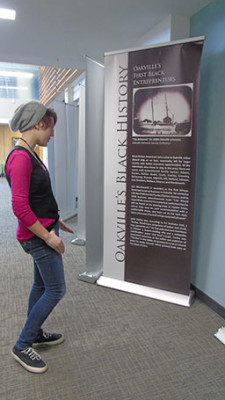Heirloom watch reveals a hidden link to town’s history
STORY BY KELSEY LYONS
PHOTO BY KELSEY LYONS/ THE SHERIDAN SUN

Art Fundamentals student Marissa Naylor checks out Freedom’s Story exhibit in the Trafalgar Campus Learning Commons.
Branson Johnson had a scar on his upper lip from a dog bite, something that his family wouldn’t have even known without a particular document that is the main attraction in an exhibit that opened last week in the Learning Commons.
Last Monday, the Oakville Museum brought part of their Freedom’s Story exhibit to Sheridan.
The exhibit is brought to Sheridan through Sheridan Reads and the Faculty of Humanities and Social Sciences.
“Sheridan Reads is bringing students, staff and faculty together… to discuss and celebrate the work of writers from home and abroad,” said Sean McNabney, acting associate dean, Faculty of Humanities and Social Sciences.
Throughout the winter term, Sheridan Reads will have a community wide reading experience based on Lawrence Hill’s Book of Negroes.
The exhibit shows Oakville’s role in the Underground Railroad.
“People are very surprised because it’s not a well known part of the Underground Rail road story, that there was anything in Oakville,” said Bill Nesbitt, supervisor of the Oakville Museum.
Johnson and many other U.S. families relocated in Oakville in the 1800s. He was born a free African-American man and he was given freedom papers that proved so.
Freedom papers were given to African-Americans that were born in slave-free states to prove that they weren’t runaway slaves.
These papers noted that Branson was 23, he was 5-foot-6 tall and any notable physical characteristics, including the scar on his upper lip.
Branson passed down two watches to his son, Oliver (Ollie) Johnson, who then gave them to his son, Oakville’s Joe Johnson.
Joe was cleaning the larger watch in the ’70s and he discovered something.
“I got a little emery cloth and I’m wiping this thing off and I’m wiping this thing off and it opened up. There’s these papers that fell out,” said Joe, in a video produced for the exhibit.
“I opened up the paper and it was Ollie’s father’s freedom papers and I’d never seen freedom papers, I didn’t even know anything about them.”
Although, Joe found the papers many years ago, he didn’t give the museum a call until 2008.
The document was brought to the conservation lab and the staff cleaned off the mold and they put it into a preservation chamber to keep it from deteriorating further.
“Starring in our exhibit we have here is the account of a remarkable document that reminds us how precious freedom is,” said Carolyn Cross, curator of collections at the museum. “And how we should never forget that freedom always comes at a price.”
The staff at the museum were able to talk to Joe on numerous occasions before he died in 2011 at the age of 75.
“It was very important to Joe that this incredible piece of history find a permanent home in Oakville,” says Cross.
When Joe came to donate the pocket watch to the museum he discovered a part of his own story that he didn’t know himself.
Nesbitt says that coincidentally because of the history already a part of the exhibit, they had been in contact with Joe’s biological mother’s side of the family, which Joe never met.
“And they said ‘Yeah we kinda knew about this. It was a family secret. We talked about it, but we’ve always wondered about this guy’,” says Nesbitt. “So we actually reunited the two families and they had tea at the museum one day and sort of swapped letters, photographs and it was really one of the most heartwarming things that’s happened to me working in museums.”